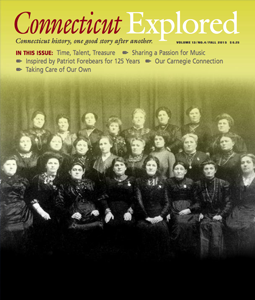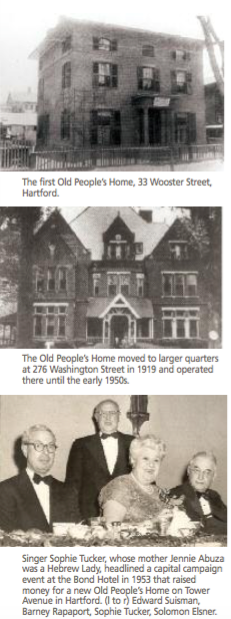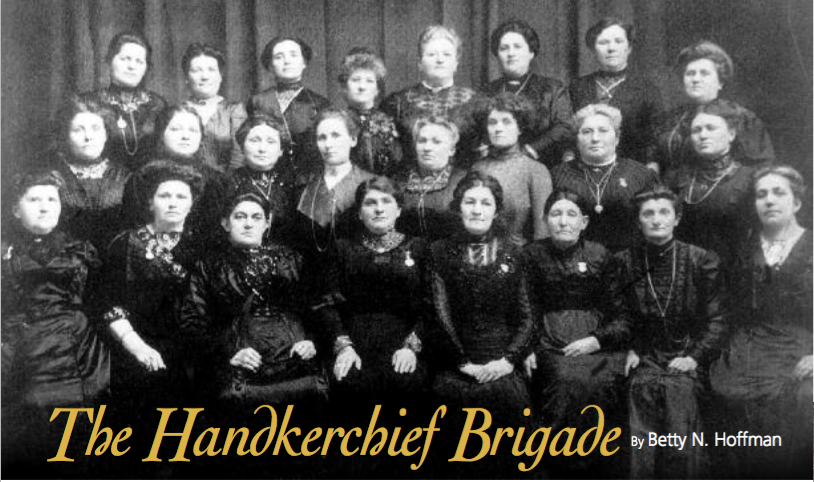(c) Connecticut Explored, Fall 2015
Subscribe/Buy the Issue!
[They belonged] to the era of the famous Handkerchief Brigade, when noble women ploughed through mud, rain, snow, and blizzards to collect pennies, nickels and dimes at the beginning of our great charitable undertaking. The community was small, the people poor, and such work meant severe personal sacrifice and hardship….
— From a 1947 Hebrew Home tribute to Bayla Katzman
Coming from a religious tradition that prized joining together as a community to assist those in need, 124 Hartford immigrant women formed the Hebrew Ladies Sick Benefit Aid Association (Hebrew Ladies) in 1898. Their plan was to provide $3 a week to any member suffering from illness. During the first three years, however, most members deferred drawing upon the association for their medical needs, and the treasury continued to grow.
In 1901 organization President Sima Israel called a meeting of her close friends, all Hebrew Ladies, at the home of Bayla Katzman on Madison Street in Hartford to discuss the plight of an acquaintance. The woman was alone in the world, old and ill, and without money. Israel proposed that the Hebrew Ladies consider changing the focus of their group from financially supporting sick Ladies and their families to providing assistance to old, impoverished members of the Jewish community.
All of those present—Sima Israel, Bayla Katzman, Mary Newman, Etta Wasserman, Jennie Abuza, Rose Levin, and Rachel Traub—pledged to donate five cents a week and recommended redirecting the Sick Benefit treasury to the new undertaking. They decided to build an Old People’s Home to provide for the health and safety of its residents in an appropriate Jewish setting.
When they presented this plan to the larger membership, the group agreed to canvass friends and neighbors weekly for donations. Because they wrapped the donated coins in their handkerchiefs, they became known, as The Hartford Courant later reported (January 24, 1932), as the Handkerchief Brigade.
 Raising funds to establish a home was a slow process. The Hebrew Ladies occasionally had to dip into their treasury to pay sick benefits, to assist indigent elderly Jews being cared for in private homes, and to make loans to other Jewish groups. By 1907 the Hebrew Ladies, assisted by the men of the Hartford Jewish community, had collected $1,000 and arranged for interest-free loans to purchase a 17-room house at 33 Wooster Street in the city for $5,000.
Raising funds to establish a home was a slow process. The Hebrew Ladies occasionally had to dip into their treasury to pay sick benefits, to assist indigent elderly Jews being cared for in private homes, and to make loans to other Jewish groups. By 1907 the Hebrew Ladies, assisted by the men of the Hartford Jewish community, had collected $1,000 and arranged for interest-free loans to purchase a 17-room house at 33 Wooster Street in the city for $5,000.
To keep costs down, some members volunteered to supervise the home on a rotating basis, for three months at a time. The volunteers were responsible for the care of the “inmates” and for all of the housekeeping chores. The doctors also volunteered their time.
The year 1911 opened with a new name for the organization—the Hebrew Ladies Old People’s Home—and a community campaign collected $2,000 to refurbish the facility. Judging from the size of the individual donations, listed in the 1911 annual report as one tablecloth, six towels, one pillow, one clock, one plant, and such, the Jews of Hartford, no matter how little they may have had for themselves, felt responsible for caring for those even less fortunate. Those who could afford it, as Rabbi Morris Silverman recounted in Hartford Jews: 1659-1970 (Connecticut Historical Society, 1970), made larger donations: bread for two months, four tons of coal yearly, fish for six months, liquor and spirits, and cash.
Sarah P. Suisman was a member of the Handkerchief Brigade, later the president of the Hebrew Ladies, and a major supporter. When her grandson Michael Suisman put together a family history, he wrote, “Sarah it was who went door to door with a pushke [a little box for collecting charity coins], often accompanied by her friend Anna Weiner, pleading for nickels and dimes ‘for the old people.’” By 1919, the organization needed to expand. Sarah’s husband Michael lent the Hebrew Ladies $3,000 of the $8,000 purchase price to buy the larger George H. Hogle house on Washington Street, the next Hebrew Ladies Old People’s Home.
By the late 1940s the Washington Street building had outlived its usefulness. Sarah called on her son Edward Suisman. With Judge Solomon Elsner as the new fundraising campaign’s honorary chairman, they rallied the Hartford Jewish community to pledge its support. Rebecca Naboicheck’s involvement with the Handkerchief Brigade also influenced her son N. Aaron Naboicheck to get involved.
As part of that campaign, in 1953 the Hartford-born, world-famous singer Sophie Tucker, known as the “Last of the Red Hot Mamas” and whose mother Jennie Abuza was a Hebrew Lady, Home founder, and member of the Handkerchief Brigade, entertained at a fundraising dinner for the construction of the new Tower Avenue home. That evening raised more than one million dollars, approximately half of the total needed for the new building. [See “Sophie Tucker: Last of the Red Hot Mamas,” Spring 2006.]
By the mid-1980s, once again, a new facility was needed. Today Hebrew HealthCare occupies a 25-acre site off Bloomfield Avenue in West Hartford and houses approximately 320 long-term and hospital residents. The Hebrew Ladies Old People’s Home has come a long way from the small house on Wooster Street with its four original residents, a rotating roster of volunteers, and many small coins collected in ladies’ handkerchiefs.
Betty N. Hoffman has conducted oral histories in and written extensively about the Greater Hartford Jewish community for more than 25 years.
All images courtesy of the Jewish Historical Society of Greater Hartford.
Explore!
“Sophie Tucker: Last of the Red Hot Mamas,” Fall 2006
“Making Their Presence Known” Summer 2005

